1/48 Special Hobby "V-173 Flying Pancake"
Completed in 2020. Though I've started half-a-dozen or so aircraft models over the decades, this is the first one I've ever finished. The kit has some serious faults. Even the plastic it's made of is a problem. (It splits and cracks under stress, and in reaction to liquid cement.) But I managed to complete the model by persevering. The fact that the V-173 is one of my favorite planes is what motivated me. (Details of the build are here: http://cs.finescale.com/fsm/modeling_subjects/f/2/t/182070.aspx )
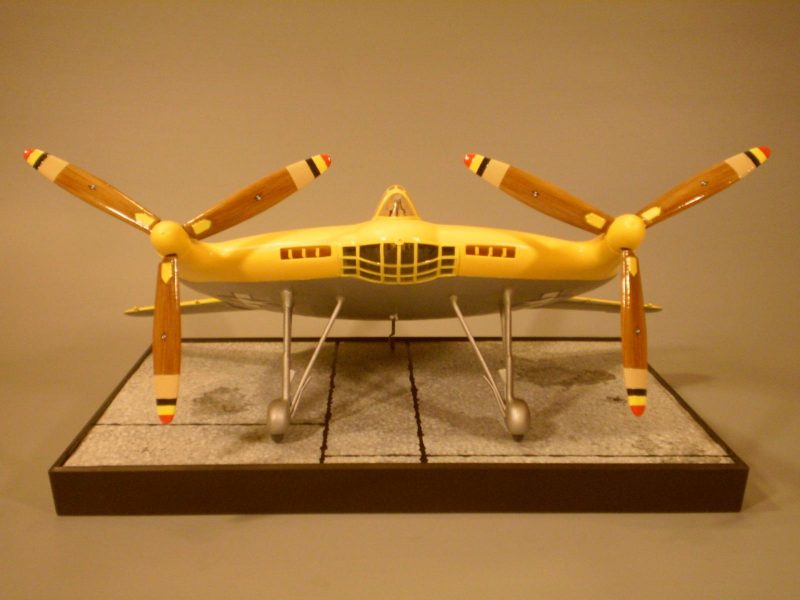

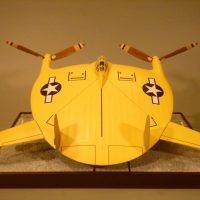
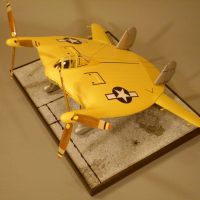
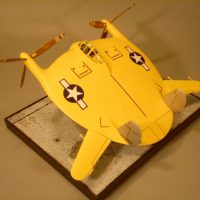
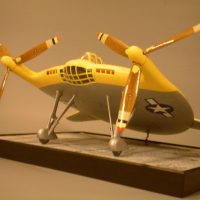
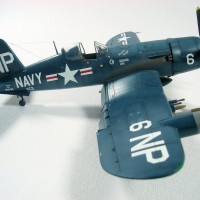
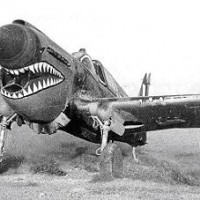

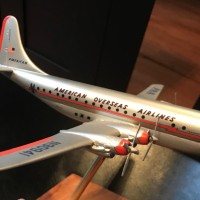
This is a wonderful build of a very difficult kit, Tom.
It's such a rare subject to see built.
I love the wooden look of the propellers and the excellent clear parts frame painting.
Congratulations and welcome aboard iModeler!
Thank you Spiros. There are two other builds of this kit here on iModeler, both posted in 2016. I often looked at them for inspiration while struggling with construction. Most of the framing on the clear parts was done with decals - a sheet of yellow stripes from Print Scale.
As Spiro said! IIRC aren't the prop textures available as decals somewhere?
I think so. But it's so easy to do by hand. Use a light yellow-brown acrylic for a base coat. Then wash the prop with brown or red-brown artist's oil paint, thinned with a mild solvent. Then streak the prop using the cut edge of a sponge or packaging foam.
Thanks, I'll try that on some Evergreen strip to see if I can get it figured out. The props are such a focal point of this kit that they need to look right. Yours do!
These pics might help. Let the artist's oil paint dry for a week, then varnish the props by hand-brushing them with Future (Pledge). Then you can apply the decals (and add a second coat of varnish over them), mask and spray the stripes, etc.
2 attached images. Click to enlarge.
Nice job on it, all finished, it looks great!
Thank you Walt!
This is a great accomplishment. I know how hard this kit is because it defeated me several years ago. Definitely a triumph of talent, skill and perseverance over material. It looks great.
Thank you Tom. Perseverance, yes. But as someone else here on iModeler once said, I had to overcome my modeling skills! 🙂
Tom, This is by far my favorite "What were they thinking" aircraft. With that said, I've always enjoyed a fine built model of it, like you've done here. I really like the paint scheme, and the wood grain on the props looks really great.
Thank you Terry.
Didn't think it was possible to makes this kit look so good. Well done!
Thank you Haslam. Here's an example that puts mine to shame: https://www.britmodeller.com/forums/index.php?/topic/235005084-vought-v-173-flying-pancake-special-hobby-148/
A fantastic job! Well done, and welcome aboard.
Thank you Robert.
🙂 ... Greetings ... 🙂 :
Welcome to this forum. I must say Tom, as for your first and hopefully not last post, you have made a visual impact. True ... it is not a model that is often seen, but this model looks very good,
even your propeller work is well done. Thank you for sharing the images.
Thank you DE4EVER.
Welcome Tom.
Your perseverence really paid off.
At the end, building a tough model which is looking this good, must give you satisfaction.
Thank you John. Yes, it's very satisfying to complete a kit with serious faults - and to fix the many mistakes I made, big and small, while building it.
Sure looks great to me, especially the wood props. Glad you hung in there. I built the Sword same scale version of this Pancake and was very happy with it, even though it doesn’t have a whole lot of detail as yours. I also have this Special Hobby kit sitting on the stash shelf but after reading what you and TC have to say about building this, it’s going to stay there a lot longer. Thanks for posting Tom.
Thank you Eric. If you ever decide to tackle the Special Hobby kit, here’s what to watch out for. (1.) Cut off the top half of the main gear struts and switch them around, left and right, so the struts will mount vertically. (2.) The bottom window is a terrible fit, and at the very least will need to be shimmed on the sides. You can go further and build up with putty all around it. (3.) The cockpit assembly won’t allow the top and bottom halves of the wing-fuselage to come together, so surgery is needed: cut down the area behind the pilot’s seat; grind off the locating ridges for the cockpit assembly on the bottom half of the wing-fuselage; thin the centerline-facing panels of the air exhaust wells on the upper half of the wing-fuselage. (4.) The dividers in the air intakes should be flush with the leading edge of the wing-fuselage, so the kit’s dividers have to be lengthened with styrene and then blended with the leading edge – something I neglected to do. (5.) Thin the wheels as they’re too thick to allow the halves of the spats to come together.
Wow. That’s quite a heads up. Much appreciated.
You're welcome. 🙂